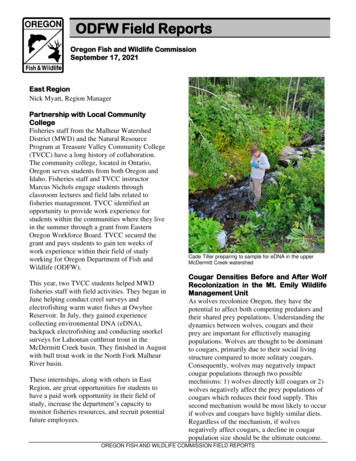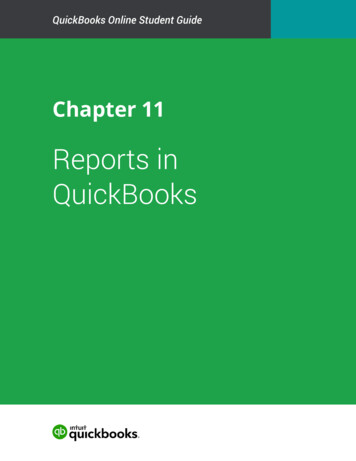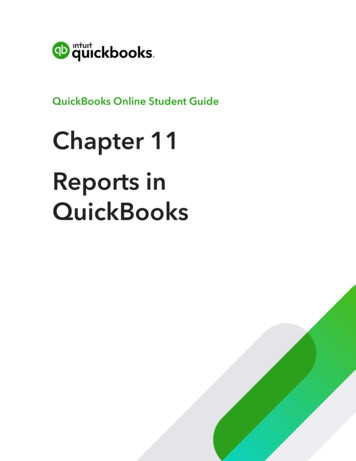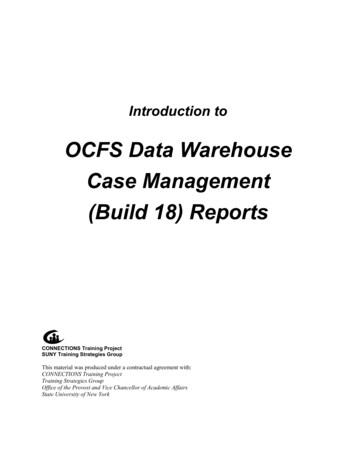
Transcription
ODFW Field ReportsOregon Fish and Wildlife CommissionSeptember 17, 2021East RegionNick Myatt, Region ManagerPartnership with Local CommunityCollegeFisheries staff from the Malheur WatershedDistrict (MWD) and the Natural ResourceProgram at Treasure Valley Community College(TVCC) have a long history of collaboration.The community college, located in Ontario,Oregon serves students from both Oregon andIdaho. Fisheries staff and TVCC instructorMarcus Nichols engage students throughclassroom lectures and field labs related tofisheries management. TVCC identified anopportunity to provide work experience forstudents within the communities where they livein the summer through a grant from EasternOregon Workforce Board. TVCC secured thegrant and pays students to gain ten weeks ofwork experience within their field of studyworking for Oregon Department of Fish andWildlife (ODFW).This year, two TVCC students helped MWDfisheries staff with field activities. They began inJune helping conduct creel surveys andelectrofishing warm water fishes at OwyheeReservoir. In July, they gained experiencecollecting environmental DNA (eDNA),backpack electrofishing and conducting snorkelsurveys for Lahontan cutthroat trout in theMcDermitt Creek basin. They finished in Augustwith bull trout work in the North Fork MalheurRiver basin.These internships, along with others in EastRegion, are great opportunities for students tohave a paid work opportunity in their field ofstudy, increase the department’s capacity tomonitor fisheries resources, and recruit potentialfuture employees.Cade Tiller preparing to sample for eDNA in the upperMcDermitt Creek watershedCougar Densities Before and After WolfRecolonization in the Mt. Emily WildlifeManagement UnitAs wolves recolonize Oregon, they have thepotential to affect both competing predators andtheir shared prey populations. Understanding thedynamics between wolves, cougars and theirprey are important for effectively managingpopulations. Wolves are thought to be dominantto cougars, primarily due to their social livingstructure compared to more solitary cougars.Consequently, wolves may negatively impactcougar populations through two possiblemechnisms: 1) wolves directly kill cougars or 2)wolves negatively affect the prey populations ofcougars which reduces their food supply. Thissecond mechanism would be most likely to occurif wolves and cougars have highly similar diets.Regardless of the mechanism, if wolvesnegatively affect cougars, a decline in cougarpopulation size should be the ultimate outcome.OREGON FISH AND WILDLIFE COMMISSION FIELD REPORTS
The East Region Wildlife Research Programconducted a study to determine if wolvesnegatively affected cougar populations in theyears following wolf recolonization of the Mt.Emily Wildlife Management Unit (WMU).ODFW Wildlife Research staff used scatdetecting dogs to locate cougar scat on thelandscape and subsequent genetic analysis toidentify the individual cougar that deposited thescat. This information was then used to estimatepopulation density. In 2011, prior to wolfrecolonization of the Mt. Emily WMU, cougardensities across all age classes were estimated at13 cougars/100 miles2. In 2012 cougar densitieswere estimated at 15 cougars/100 miles2. Wolveswere first documented in the Mt. Emily WMU in2012, but they were not known to occur in areaswhere cougar scats were sampled. By 2017,multiple wolf packs were established within theMt. Emily WMU and overlapped areas cougardensities were previously estimated. Theestimated cougar density in 2017 was 16cougars/100 miles2. The diffrences in cougardensity between 2011, 2012, and 2017 were notstatistically different and suggests cougardensities have been relatively stable between2011 and 2017 despite wolves recolonizing thearea.population via this mechnism. Wolves andcougar diets had some overlap, but wolf dietsincluded mostly elk, where cougar diets weremostly deer. Given the differences in diet,competition between wolves and cougars may beminimal at this time and population level effectson cougars were not observed. However, wolvesrecently recolonized the study site ( 5 years) andas wolves become better established and preypopulation sizes increase or decrease over time,the dynamic between wolves, cougars, and theirprey is likely to become more pronounced.Periodic efforts to estimate cougar density infuture years will help clarify the response ofcougars to wolf recolonization and associatedchanges in prey populations.West RegionChris Knutsen, Interim Region ManagerTribe on screens projectsThe Central Point and headquarters fish screenprogram staff recently met with a Klamath Triberepresentative to provide updates on completed,current and future fish screening and passageproject accomplishments in the KlamathBasin. The presentation also included othervaluable information such as funding partners,types of screens that work well in particularsituations, and project cost breakdowns. TheKlamath Tribal representative was pleased withthe information and updates provided, and thealignment with the Klamath Tribe continues tobe positive.The presentation provided known points ofdiversion (PODs), in various Klamath Basinwaterbodies, how many were screened andunscreened, and outlined juvenile salmon andsteelhead screening criteria and risk assessment.The groups discussed and prioritized futureviable projects for the next couple of years.Cougar with radio collar used for researchAs wolves recolonized the Mt. Emily WMU,cougars were also collared to determine theirmovements, survival, and diet. Between 20142016, we documented no direct predation ofadult cougars by wolves. This lack of directkilling of cougars by wolves suggests wolveswere unlikely to negatively effect the cougarThe Central Point screens shop covers fishscreening needs for Lake, Klamath, Jackson,Josephine, Douglas, Coos, and Curry countieswith most work centered in the Rogue Basin,Klamath, and Lake counties. Once projects areprioritized by fish district staff, shop staff createthe initial screening concept and approachlandowners, water users, and funding partnersfor their approval. Headquarters engineers thenOREGON FISH AND WILDLIFE COMMISSION FIELD REPORTS
design the screens, and Central Point screensstaff build, install, and in most cases assume arole in maintaining the screens.lower river tributaries as wild or hatchery.Because of the success of this project, snorkelsurveys were identified in the Draft Rogue SouthCoast Multi-Species Conservation Plan (RSP) asa key monitoring tool. These surveys areimportant work informing the RSP developmentand implementation around stray rates, fishing,and monitoring actions. The hatchery programhas remained the same size (50K smolts) forover 30 years.Pump Ditch, 26.9 cfs on the Wood River built by CentralPoint screens shop staffODFW Staff snorkeling the Chetco RiverClackamas River to receiveaugmentation flows beginning Sept. 1As of mid-August, flows in the lower ClackamasRiver are hovering around 700 cfs. Theseextremely low flows led staff to attend a meetingwith Clackamas Water Providers and PGE todiscuss augmenting flow to the lower ClackamasRiver through water releases from TimothyLake.Staff constructed this solar powered, vertical panel screenwith wiper brush and belt screen cleaner on Simonsen #1POD. The solar-powered belt screen transfers debris backinto the water behind the screen.Chetco River Hatchery Winter SteelheadMonitoringThe Chetco River watershed is very remote anddifficult to access with anglers being able to onlyfish the lower 15 river miles. Past creel surveysshow very few hatchery fish are caught upstreamof Rivermile 8 and now Gold Beach staff fromODFW’s South Coast District began conductingsnorkel surveys two years ago to documenthatchery fish spawning in the wild on theChetco.Snorkel monitoring over the past two yearscategorized several hundred adult steelhead inThe Clackamas Water Providers pursued anextension of a municipal water right that hasbeen contested in court for over 15 years. Due tothis, augmenting flows to the lower Clackamasthis summer was a voluntary action initiated byClackamas Water Providers consistent to what isexpected when a final order on the water rightextension is implemented.Starting September 1 as part of an existingFederal Energy Regulatory Commission (FERC)agreement, Clackamas Water Providers will askPortland General Electric (PGE) to increaseflows from Timothy Lake into the Oak GroveFork to 50 cfs over the current release level andhold it steady until October 31. This actionshould benefit fall Chinook and coho in thelower Clackamas while also enhancing flows forspring Chinook spawning in the Oak Grove ForkOREGON FISH AND WILDLIFE COMMISSION FIELD REPORTS
and the upper Clackamas River downstream ofthe Oak Grove Fork.Battling invasive Ludwigia at PalenskyWildlife AreaWillamette Wildlife Mitigation Program(WWMP) biologists first detected the invasiveLudwigia spp. at Palensky Wildlife Area in June.Young plants along the shoreline of HorseshoeLake, the largest water body on the property thatholds water year-round were observed alongwith two small mats in the lake. In just a weekthe mats doubled in size, other mats emerged andplants on the shoreline became prolific.The dense mats of Ludwigia spp. choke outnative vegetation, prohibiting light penetrationand making it impossible for wildlife to navigatethrough them. It can also greatly reduce theamount of dissolved oxygen in the water, whichis detrimental to aquatic fish and wildlife.Ludwigia spp. have invaded the nearby Smithand Bybee Wetlands Natural Area and numerousareas upstream of Palensky Wildlife Area.Spread is mostly clonal with plant fragmentseasily dispersed by water and wildlife. It was justa matter of time before this plant showed up atPalensky Wildlife Area.to seek assistance with a long-term managementstrategy as IRM has worked on several Ludwigiamanagement projects throughout the WillametteValley.Chum Salmon Reintroduction: Adult OutplantingLarge numbers of adult chum salmon returned tolower Columbia River tributaries in the fall of2020, including nearly 1,000 fish returning toBig Creek Hatchery. At Big Creek they werespawned as conservation broodstock for theODFW Chum Salmon Reintroduction project.For the first time since project inception in 2010,we maxed out the hatchery’s capacity to rearjuvenile chum salmon and released over 350,000of them in the spring of 2021. In addition tomeeting goals for Big Creek Hatcherybroodstock collection and juvenile release,surplus adults in 2020 were out-planted intonearby Bear and Little Bear Creeks to evaluatethe effectiveness of natural production. Prior to2021, monitoring of juvenile salmonidproduction from the Bear Creek watershed since2017 has revealed limited natural production(2 25 out-migrants captured at the trap in2018 2020). The 2021 results were quitedifferent, where 641 out-planted adults producedover 40,000 out-migrants (estimated). Geneticsamples collected from out-planted adults as wellas naturally spawning chum salmon willaugment our parental-based-tagging program toclassify juveniles produced at Bear Creek, andultimately the contribution of natural andhatchery production to the broodstock and areastreams. Finally, much of the large return to BigCreek Hatchery in 2020 was composed of threeyear-old adults. With chum salmon returning atage three, four, or five, we anticipate anotherlarge return of chum salmon in fall of 2021.Mats of invasive Ludwigia on Horseshoe Lake at PalenskyWildlife Area.WWMP biologists have been applying aquaticherbicide to the plants and will continue to do sothrough the fall. They will attempt to removedead material, but this is a logistical challengewith shallow water and deep mud. Staff also planto consult with Integrated Resource ManagementOREGON FISH AND WILDLIFE COMMISSION FIELD REPORTS
Information and EducationRoger Fuhrman, Information and EducationAdministratorAlthough it will not be the same as past years,we hope this approach will encourage people tolook into Oregon’s fish and wildlife resourcesand think about actions they can take to helpwildlife.Oregon State PoliceCaptain Casey Thomas, Fish & WildlifeDivisionOregon State Police (OSP) Fish and WildlifeDivision members conducted patrols upon CranePrairie Reservoir and Suttle Lake. The Trooperscontacted multiple individuals and issuedwarnings for various angling and boatingviolations. They also assisted a boater who’dwrapped his anchor line around his vessel’spropeller, and talked with a couple of youngboys interested in the work conducted by F&WTroopers.One of the banners featured at the State Fair this yearODFW Offers Self-Guided Option at FairAttendees at the Oregon State Fair this year willsee a different look in the natural resources area.All state agencies that normally staff booths willinstead offer self-guided experiences forfairgoers. ODFW will feature handouts, bannersand signs directing people to various onlineresources.Banners will include information about hunting,fishing, shellfish harvesting and wildlifeviewing. Each banner will direct people to newonline content. In addition, brochures and mapswill be available for people to take. And, asalways, copies of the current regulations are sureto be popular.This year, ODFW will also feature a large bannerentitled “How you can help wildlife” withinformation on a variety of topics including: theanti-poaching campaign, invasive species, andinformation about how to preventhuman/wildlife conflict.Non adipose fin-clipped coho seized by OSPOSP Fish and Wildlife Division memberschecked incoming dory boat anglers at CapeKiwanda. The dories were returning from bottomfishing, crabbing and salmon fishing trips. Onenon adipose fin-clipped coho salmon was seizedand donated to the Tillamook County Jail. Thefollowing citations and warnings were issued:-Failure to Immediately Validate Harvest Card 5 citations/3 warnings-Failure to Properly Validate Harvest Card - 2warnings-Take/Possess Non-Adipose Fin-Clipped CohoSalmon - 1 citation-No 2021 Combined Angling Harvest Card - 2citationOREGON FISH AND WILDLIFE COMMISSION FIELD REPORTS
-No 2021 Combined Angling Tag in Possession1 citationA Fish & Wildlife Trooper checking in with alegal pronghorn antelope hunterOSP recently updated their Facebook page withinformation regarding the Oregon State Police“TIP” line. A portion of that information isbelow.Don’t forget to contact your Oregon State PoliceF&W Troopers should you need assistance orshould you observe any unlawful activity. TheOregon State Police “TIP” line is monitoredtwenty-four hours a day with reported F&Wviolation information forwarded directly to F&WTroopers via the Oregon State Police DispatchCenters. We’re here to help and only a phonecall away. Good luck on your hunts and we’ll seeyou in the field!Anyone with information regarding a Fish orWildlife violation is urged to contact the Turn inPoachers (TIP) hotline at 1-800-452-7888 or*OSP (mobile).** Report Wildlife and Habitat Law Violators**The TIP program offers preference point rewardsfor information leading to an arrest or issuanceof a citation for the unlawful take/possession orwaste of big game mammals.Preference Point Rewards:* 5 Points-Mountain Sheep* 5 Points-Mountain Goat* 5 Points-Moose* 5 Points-Wolf* 4 Points-Elk* 4 Points-Deer* 4 Points-Antelope* 4 Points-Bear* 4 Points-CougarThe TIP program also offers cash rewards forinformation leading to an arrest or issuance of acitation for the unlawful take/possession or wasteof Mountain Sheep, Mountain Goat, Moose, Elk,Deer, Antelope, Bear, Cougar, Wolf, UplandBirds, Waterfowl, and Furbearers. Cash rewardscan also be awarded for the unlawful take ofGame Fish and Shellfish and for HabitatDestruction.CASH REWARDS:* 1,000 Mountain Sheep, Mountain Goat andMoose* 500 Elk, Deer and Antelope* 300 Bear, Cougar and Wolf* 300 Habitat Destruction* 100 Upland Birds and Waterfowl* 100 Furbearers* 100 Game Fish and ShellfishHow to Report a Wildlife and/or Habitat LawViolation or Suspicious Activity:TIP Hotline: 1-800-452-7888 or *OSP (677)TIP E-Mail: TIP@state.or.us (Monitored M-F8A-5P)For the full details go 3818149265Conservation ProgramAndrea Hanson, Oregon Conservation StrategyCoordinatorFoothill yellow-legged frog inventoryConservation Program staff in southwesternOregon are making progress on an inventoryproject for foothill yellow-legged frogs. Foothillyellow-legged frogs are currently under reviewfor listing under the U.S. Endangered SpeciesAct (ESA).OREGON FISH AND WILDLIFE COMMISSION FIELD REPORTS
This larval foothill yellow-legged frog can be identified bythe presence of 6-7 tooth rows above, and 5-6 tooth rowsbelow its mouthRelative to the species range in central andsouthern California, Oregon is considered astronghold for the species—though frogs havedeclined significantly in the northern andsouthwestern portions of their Oregon range.Additional “no detection” data at historical sitesmay indicate extirpations, as this species issensitive to invasive species, dams anddiversions, disease, and land use change amongother threats. Frog detections in places wherehabitat is suitable (yet no animals have beendocumented to-date) can help to incorporatemissing habitats or regions into the known corerange. Ultimately, this additional inventory workprovides fine-scale range data to inform speciesconservation by providing accurate informationabout contemporary core habitat extent.To date, staff have collected inventory data at 74sites in the Coquille, Coos, Umpqua, SouthUmpqua, Upper Klamath, Upper Rogue, MiddleRogue, Applegate, Illinois, and Lower RogueSubbasins. This survey effort is unique in thatinstead of the traditional method of detectingindividual animals visually during surveys, staffinstead are documenting frog presence bycollecting environmental DNA (‘eDNA’), orDNA of the target organism found in watersampled from suitable frog habitat sites. Whileresults are still pending from eDNA samples,incidental frog detections at survey sites havealready confirmed occupancy at onesubwatershed subunit (HUC12) where no frogpopulations had been previously documentedand in two HUC12 units where no frogs havebeen documented for at least 20 years.This is a foothill yellow-legged frog in the metamorphicstage. As this animal transitions to life in a more terrestrialenvironment, its poor swimming abilities make it especiallyvulnerable to predatorsSurvey work was funded through a GoodNeighbor Authority (GNA) partnership withU.S. Forest Service (USFS) and the Bureau ofLand Management (BLM) through theInteragency Special Status/Sensitive SpeciesProgram (ISSSSP) office. Staff (one biologist,one temporary wildlife technician, and twointerns) will continue to survey through the fallof 2021 and additionally survey work will occurin 2022.An adult foothill yellow-legged frog is seen here basking ona boulder at the edge of a streamOREGON FISH AND WILDLIFE COMMISSION FIELD REPORTS
ocean ecosystem and fisheries are represented inthe BOEM process.Locations of completed eDNA surveys areshown in red on the map above. The range ofthis species, scaled to HUC12 unit, is shown onthis map in green with historical sites (wherefrog records are 20 years old) shown in blue.This range extends farther north and east thanwhat is shown in the map above. Note that notall occupied HUC12 units were documented inOregon prior to the onset of local extirpationstied to land use change during the westernsettlement period.Marine Resources ProgramCaren Braby, Marine Resources ProgramManagerMarine Spatial Planning for OffshoreWind Renewable Energy IndustryThe ocean offshore of Oregon is home to worldclass wind and wave energy resources and hasbeen attracting attention from the renewableenergy industry for decades. As a result, this yearthe Oregon State University started constructionon the PacWave wave energy device researchfacility, which is being built approximately 6miles offshore of Newport. As the federaloffshore wind energy regulatory agency, theBureau of Ocean Energy and Management(BOEM) has been active this year building anocean maps database and interviewing oceanusers about where BOEM may site offshorewind lease areas. Department staff have playedmajor roles throughout the planning process forboth wave and wind energy as marine biologyexperts and fisheries managers, so that Oregon’sThe Department’s central role has been inproviding or commenting on data used formapping existing ocean uses and oceanresources. For the BOEM offshore wind process,the maps are housed and are available for publicaccess at the OROWind Map data portal.OROWind Map allows users to explore a varietyof ocean maps, including bottom topographysuch as rock reefs, fishery footprints, and otherinformation that will be used by BOEM forfuture designation of lease areas and decisionmaking on lease applications.Another key role for Department staff has beento help shape ocean energy policy. GovernorKitzhaber established the Oregon-BOEM TaskForce in 2011, to coordinate with BOEM onoffshore renewable energy activities, includingoffshore wind. The Task Force includes state,federal and local government officials and hasadvised BOEM on mapping, stakeholderengagement, research priorities, and marinespatial planning. Another policy developmentthis year has come from the Pacific FisheriesManagement Council (PFMC), which voted toconvene a new ad hoc advisory committee onmarine spatial planning, to engage moremeaningfully in both offshore wind andaquaculture planning efforts. Department staff siton the Marine Planning Committee for PFMC,bringing Oregon’s expertise to the region.Planning efforts for offshore wind and offshoreaquaculture are moving quickly, with strongendorsement and mandates from the federaladministration. Efforts by the Department toinform data used and shape policy developmentwill influence the future of fisheries, renewableenergy, and other ocean uses.End of field reports forSeptember 17, 2021OREGON FISH AND WILDLIFE COMMISSION FIELD REPORTS
Partnership with Local Community College Fisheries staff from the Malheur Watershed District (MWD) and the Natural Resource Program at Treasure Valley Community College (TVCC) have a long history of collaboration. The community college, located in Ontario, Oregon serves students from both Oregon and Idaho. Fisheries staff and TVCC instructor










